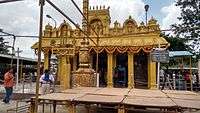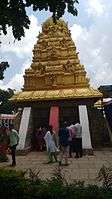Chikka Tirupati
| Chikka Tirupati | |
|---|---|
| ಚಿಕ್ಕತಿರುಪತಿ | |
 Image of the gateway tower of the temple | |
 Location in Karnataka | |
| Geography | |
| Coordinates | 12°53′44″N 77°51′55″E / 12.89556°N 77.86528°ECoordinates: 12°53′44″N 77°51′55″E / 12.89556°N 77.86528°E |
| Country | India |
| State | Karnataka |
| District | Kolar |
| Location | 15 KM from Malur or 12 KM from Sarjapura, Bangalore |
| Culture | |
| Sanctum |
Venkata Ramana Swamy (Lakshmi) |
| Direction and posture | East Facing |
| Temple tank | Right side of the god |
| Architecture | |
| Architecture | Dravidian architecture |
Chikka Tirupati (Meaning 'Small Tirupathi' in Kannada, with reference to Tirupathi in Andhra Pradesh) is a religious place having Venkateshwaraswamy temple. It is dedicated to the Hindu god Vishnu. It is located in Chikka Tirupathi hobli of Malur Taluk, in the outskirts of Bengaluru in the South Indian state of Karnataka. Constructed in the Dravidian style of architecture, the temple is considered similar to the Tirupathi Venkateswara temple. Vishnu is worshipped as Venkateshwara and his consort Lakshmi as Alamelumanga.
The temple is open from 6.30am to 7 30 p.m(all days of week) and has four daily rituals at various times of the day. The Brahmotsava, the major festival, is celebrated annually during Shravana Shaniwaara during which the festival images of the presiding deities are taken in a parade around the streets of the temple in a chariot.
An interesting part of this lord Venkateshwara idol is that it is an Abhayahastha (hand showing upwards as blessing) whereas in Tirupathi at Andhra Pradesh, Lord's hand is showing downwards. Hence this is considered to be special.
Visitors can continue their holy travel towards kolar where they can have good time in visiting Koti Lingas, Mulabagilu, Antharagange much more.
Chikkathirupathy is just 15 KM from taluk headquarters Malur, 26 km from ITPL and 30km from koramangala.
The Temple

Venkateswara temple is built in Dravidian architecture and the exact history of the temple is not known. The inscriptions in Mysore records indicate that the temple is a few centuries old. The temple has a 5-tiered gopura. The temple tank is located north of the temple. The central shrine houses the image of Venkateshwara in standing posture. There are two precincts around the temple. From the entrance tower, the central shrine is located in the axis through the Dwajasthamba (flagstaff), pillar of offering and Garuda Mantapa. The image of Garuda, the eagle mount of Venkateshwara, is housed in the Garuda Mantapa, facing the image of the presiding deity. The temple in modern times is administered by the Department of Religious Endowment, Government of Karnataka.[1] It is located 25 km away from Hoskote.
Worship practices and festivals

The temple is open from 8 a.m. to 7 p.m. The temple priests perform the pooje (rituals) during festivals and on a daily basis. As at other Vishnu temples in the nearby state Tamil Nadu, the priests belong to the Vaishnavaite community, a Brahmin sub-caste. The temple rituals are performed four times a day: Ushathkalam at 8 a.m., Kalasanthi at 10:00 a.m., Sayarakshai at 5:00 p.m. and Ardha Jamam at 7:00 p.m. Each ritual has three steps: alankaara (decoration), neivedhya (food offering) and deepa aradane (waving of lamps) for both Venkateshwara and his consort Alamelumanga. During the worship, religious instructions in the Vedas (sacred text) are recited by priests, and worshippers prostrate themselves in front of the temple mast. There are weekly, monthly and fortnightly rituals performed in the temple.
The temple is considered holy as the Tirupathi Venkateswara temple and devotees from other states like Andhra Pradesh and Tamil Nadu visit the temple.[2] As of November 2012, the temple had an annual revenue of ₹1 crore. The Brahmotsavam, the major festival, is celebrated annually during Shravana Shaniwara during which the festival images of the presiding deities are taken in a parade around the streets of the temple in a chariot.[1]
References
- 1 2 "Development work gives Chikka Tirupati a new look". Deccan Herald. Malur. 10 November 2012. Retrieved 22 October 2015.
- ↑ "The other Tirupati". The Hindu. 25 June 2005. Retrieved 22 October 2015.
External links
| Wikimedia Commons has media related to Chikka Tirupathi. |